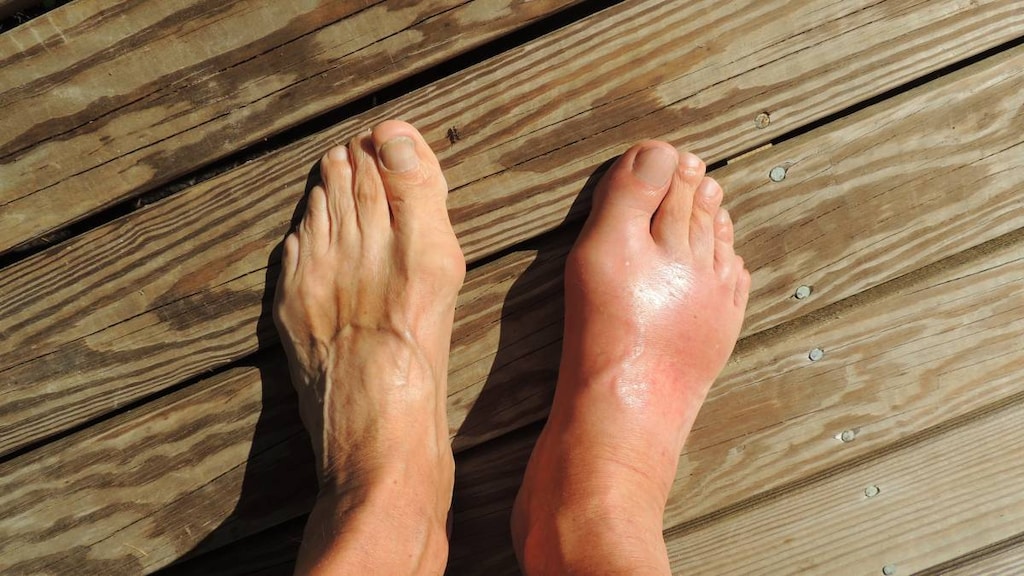
What is gout?
Gout is a type of arthritis that occurs in the small joints of the body, most commonly the big toe, although it may occur in the feet, ankles, knees, hands, and wrists. The affected joint or joints become swollen, tender and red, and look and feel "hot". Movement is usually difficult.
The pain tends to come on suddenly and reaches a peak in four to 12 hours. Although the first episode usually resolves in a few days, future gout attacks are likely to last longer and affect more joints.
Gout was once thought of as a rich man's disease because it tended to only afflict those who had access to copious amounts of food and alcohol. But modern research shows gout has little to do with wealth. Doctors know that gout occurs when uric acid crystallizes in a joint. Uric acid is a waste product that is formed when purines - crucial substances found in protein and other foods - are broken down. Under normal conditions, uric acid dissolves in the blood, passes through the kidneys, and is excreted in the urine. Not so in people with gout.
But while people with high levels of uric acid in their body are more likely to get gout, the relationship between uric acid and gout is not clear-cut. Gout doesn't affect everybody who has high uric acid levels and sometimes gout attacks occur when levels are low. However, it is our immune system fighting uric acid crystals in the joint that causes swelling, redness and intense pain.
Who is more at risk of gout?
Gout is more likely to occur in:
- Men. Men have a seven to nine times higher risk of gout than women, although the risk increases for women after menopause
- People with a diet high in purine-rich foods such as red meat, organ meats (such as kidneys, liver, or brains), seafood (for example, herring, mussels, or sardines). Processed foods (for example chips, frozen dinners), refined carbohydrates (such as white bread and white rice) and beverages high in fructose or sucrose also contribute to gout
- Certain ethnicities (such as African Americans, Hmong Chinese, Pacific Islanders)
- People who overindulge in alcohol, particularly beer and spirits
- People with certain medical conditions (such as cancer and psoriasis), taking certain medications (like aspirin or diuretics), or undergoing specific treatments such as chemotherapy or radiation therapy
What are the symptoms of gout?
Symptoms of gout almost always occur suddenly, and often at night and may include:
- Excruciating pain in a joint such as the big toe, ankle, elbow, wrist or fingers. Even the weight of a cotton bed sheet on a gout-inflicted toe is often too much to bear
- The affected joint is swollen, tender, red, and feels warm to the touch
- A limited range of motion in the affected joint(s)
- Lingering discomfort in a joint once the initial intense pain has subsided. This may last a few days to a few weeks. Subsequent gout attacks tend to last longer and affect more joints
How is gout diagnosed?
If you experience sudden, intense pain in a joint, see your doctor for a diagnosis. Gout that is not treated can cause irreversible joint damage, kidney stones and the formation of tophi. Tophi are small, chalk-colored, stone-like deposits of uric acid that collect under the skin and are most frequently found in skin around the joints and on the outside of the ear.
Your doctor will ask you questions about your symptoms, perform a physical examination, and run some blood tests.
How is gout treated?
Gout treatment can be categorized into medicines used to treat an acute attack, and medicines used to prevent gout complications, such as tophi.
Medicines used to treat gout attacks relieve pain and inflammation and include:
- Nonsteroidal anti-inflammatory drugs (NSAIDs)
- Colchicine
- Corticosteroids.
Medicines to prevent recurrences of gout either block the production of uric acid or improve its removal. Examples include:
- Allopurinol
- Febuxostat
- Pegloticase
- Probenecid.
Ideally, doctors aim for a target uric acid level of less than 6.0mg/dL (360 µmol/L) for most people with hyperuricemia associated with gout.
Although medications are the most effective way to prevent and treat gout, a few lifestyle changes go a long way in reducing the risk of future attacks.
- Avoid sweetened drinks containing fructose or sucrose, and alcoholic beverages such as beer and spirits. Drink plenty of water.
- Limit your intake of purine-rich foods such as red meats, organ meats, and seafood. Eat mostly fresh vegetables and use low-fat dairy products as a protein source.
- Exercise regularly and lose weight if you are overweight.

